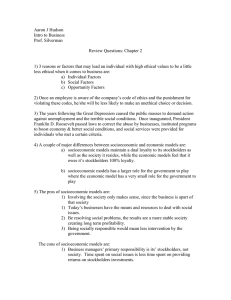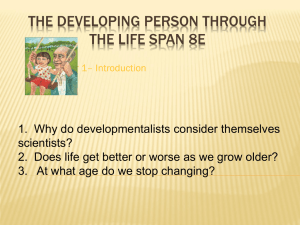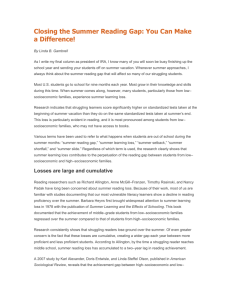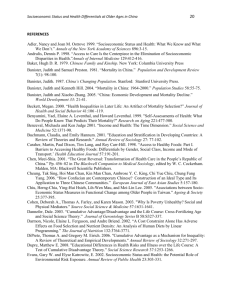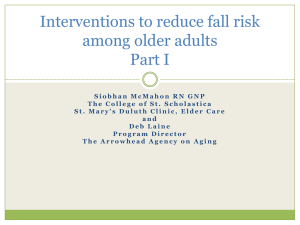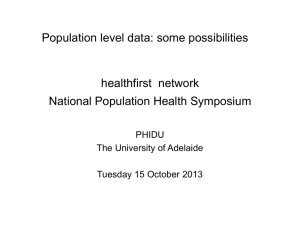Diversity in the Classroom Checklist for Educators
advertisement
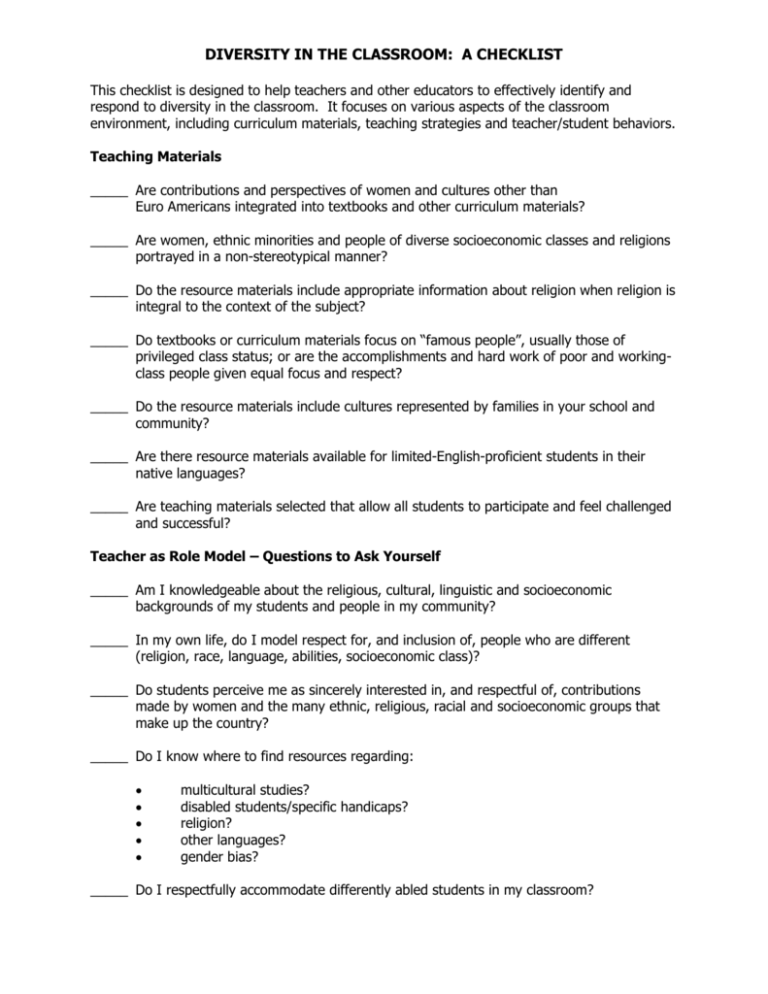
DIVERSITY IN THE CLASSROOM: A CHECKLIST This checklist is designed to help teachers and other educators to effectively identify and respond to diversity in the classroom. It focuses on various aspects of the classroom environment, including curriculum materials, teaching strategies and teacher/student behaviors. Teaching Materials _____ Are contributions and perspectives of women and cultures other than Euro Americans integrated into textbooks and other curriculum materials? _____ Are women, ethnic minorities and people of diverse socioeconomic classes and religions portrayed in a non-stereotypical manner? _____ Do the resource materials include appropriate information about religion when religion is integral to the context of the subject? _____ Do textbooks or curriculum materials focus on “famous people”, usually those of privileged class status; or are the accomplishments and hard work of poor and workingclass people given equal focus and respect? _____ Do the resource materials include cultures represented by families in your school and community? _____ Are there resource materials available for limited-English-proficient students in their native languages? _____ Are teaching materials selected that allow all students to participate and feel challenged and successful? Teacher as Role Model – Questions to Ask Yourself _____ Am I knowledgeable about the religious, cultural, linguistic and socioeconomic backgrounds of my students and people in my community? _____ In my own life, do I model respect for, and inclusion of, people who are different (religion, race, language, abilities, socioeconomic class)? _____ Do students perceive me as sincerely interested in, and respectful of, contributions made by women and the many ethnic, religious, racial and socioeconomic groups that make up the country? _____ Do I know where to find resources regarding: multicultural studies? disabled students/specific handicaps? religion? other languages? gender bias? _____ Do I respectfully accommodate differently abled students in my classroom? _____ Do I recognize and acknowledge the value of languages other than standard English? _____ Can I recognize and constructively address value conflicts based on race, religion or socioeconomic class? Teacher/Student Interactions _____ Am I careful not to prejudge a student’s performance based on cultural differences, socioeconomic status or gender? _____ Do I promote high self-esteem for all children in my classroom? Do I help each child to feel good about who he/she is? _____ Do I encourage students to understand and respect the feelings of others who are different from them? _____ Do my students see me as actively confronting instances of stereotyping, bias and discrimination when they occur? _____ Given what I ask students to talk or white about, do I avoid placing value on having money, spending money or major consumer products? _____ Do I put myself in the place of the limited-English-proficient student task, “How would I feel in this classroom?” _____ Do I make an effort to learn some words in the home languages that my limited-Englishproficient students speak? _____ Am I conscious of the degree and type of attention I am giving to members of each gender in classroom interactions? Do I have an equitable system for calling on students? _____ Do I use gender-neutral language? _____ Do I teach about religion, rather than teaching religion or ignoring religion altogether? _____ When teaching about religion, do I: place religion within historical and cultural context? use opportunities to include religion in history, literature and music? avoid making qualitative comparisons among religions? avoid soliciting information about religious affiliations or beliefs of my students? Teaching Children To Be Proactive _____ Do I teach children to identify instances of prejudice and discrimination? _____ Do I help my students develop proper responses to instances of prejudice and discrimination? General Strategies _____ Do I involve parents and other community members to help children develop greater understanding of the benefits and challenges of living in a culturally diverse society? _____ Do I inform parents of my multicultural, anti-bias curriculum? _____ Do I support and encourage the hiring of minority teachers and staff? _____ Do I build a secure and supportive atmosphere by creating a noncompetitive classroom environment? _____ Do I use opportunities such as current events to discuss different cultures and religions? _____ Do I provide students with opportunities to problem-solve issues of inclusiveness? _____ Do I use activities that demonstrate how the privilege of groups of higher economic status is directly connected to the lack of privilege of lower socioeconomic status people? _____ Do I have students examine and analyze the representation of class, race, gender, ability and language differences in media and their community? _____ Do I recognize that tracking reinforces “classism” and is counterproductive to student learning at all ability levels? _____ Do I utilize children’s literature to help students understand and empathize with individuals who have experienced prejudice and discrimination and to discuss important social issues? Developed by Karen Matsumoto-Grah, and found in Common Bonds: Anti-Bias Teaching in a Diverse Society (1992). Wheaton, MD: Association for Childhood Education International.
